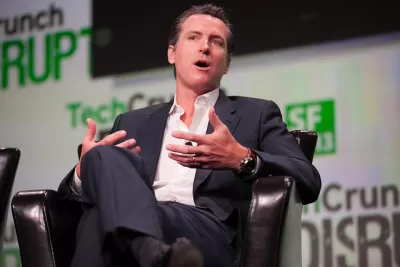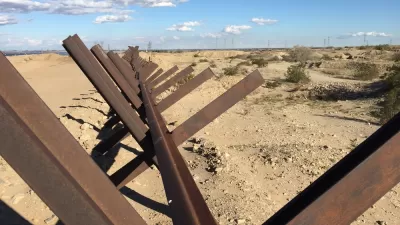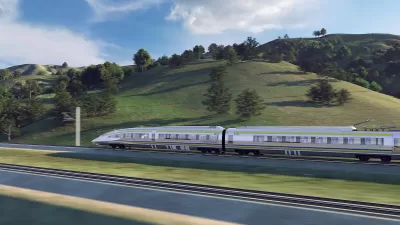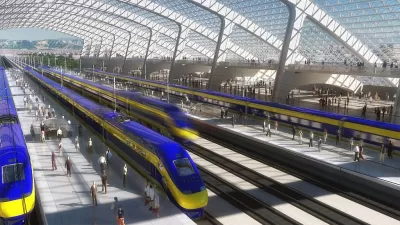The beleaguered project is still very much alive, despite some media claims to the contrary. As for the Trump administration's claim to two grants awarded to the now-$77 billion project, the state has a deadline to meet if it wants to keep them.

Did California Governor Gavin Newsom (D) "dramatically downsize the high-speed rail project," as Planetizen and other outlets inferred from his first state-of-the-state address to lawmakers on Feb. 12?
Ben Adler, capitol bureau chief for Sacramento's NPR-affiliate, Capital Public Radio, provides much-needed answers to the status of the nation's largest mega-project based on interviews with four top officials in the governor’s office and Newsom administration.
Readers may wish to listen to the 2-minute tape of his piece, originally published on Feb. 14, and most importantly, updated on Feb. 21 to comment on the Federal Railroad Administration's attempt to recoup $3.5 billion awarded to the $77 billion project.
First, the San Francisco-to-Los Angeles project, as most people know it, wasn't actually downsized. "Don’t even say 'paused' or 'scaled back,'” as Adler writes below. Ponder the two most overlooked words in the governor's speech: "as planned."
“Let’s be real,” the governor told a joint session of the California Legislature on Tuesday. “The current project, as planned, would cost too much and, respectfully, take too long.”
Newsom continued:
“We’ll finish phase one of the environmental work,” Newsom announced, referring to the environmental review of that full segment. (To clarify: Phase one is the 520 mile, SF-to-Anaheim segment. The Central Valley stretch is a subsection of that larger segment.)
Click on this interactive map by the California High-Speed Rail Authority to understand project phases and project sections.
In other words, forget “canceled” or “abandoned.” Don’t even say “paused” or “scaled back.”
The most you can really say about the Bay Area-to-Anaheim stretch known as “Phase 1” is that it’s merely on the back burner for the time being.
Adler's updated article adds clarity to the Federal Railroad Administration's attempt to "cancel the $929 million in Federal grant funds yet to be paid for the California High-Speed Rail project (and) seek the return from California of $2.5 billion in Federal funds FRA previously granted..." [Also, see prior post.]
The money came with three strings attached:
- Spend the $2.55 billion in stimulus funds by September 2017. This requirement has been met [pdf].
- Complete environmental reviews on the full 520 mile San Francisco-to-Anaheim segment known as “Phase 1” by December 31, 2022. The High-Speed Rail Authority says it has “environmentally cleared” the 171-mile stretch from Merced to downtown Bakersfield called for by Newsom and is “progressing on the remaining project sections.”
- Complete construction on the 119-mile stretch from Madera to the outskirts of Bakersfield by December 31, 2022. That work is underway.
Bottom line: "The state has less than three years to finish all its environmental reviews and complete the 119 miles of track from Madera to northern Bakersfield," notes Adler. But the bottom line only holds for the Trump administration. The outlook could dramatically change depending on what happens on Nov. 3, 2020, as he notes below.
If Democrats win the White House and control of Congress in next year’s elections, high-speed rail funding could be right back on the table — at which point California will be ready to ask for new federal funding to keep building.
Related in Planetizen:
-
February 21, 2019
-
February 16, 2019
-
February 13, 2019
FULL STORY: No, Gavin Newsom Didn’t Just Kill California’s High-Speed Rail Project

Maui's Vacation Rental Debate Turns Ugly
Verbal attacks, misinformation campaigns and fistfights plague a high-stakes debate to convert thousands of vacation rentals into long-term housing.

Planetizen Federal Action Tracker
A weekly monitor of how Trump’s orders and actions are impacting planners and planning in America.

Chicago’s Ghost Rails
Just beneath the surface of the modern city lie the remnants of its expansive early 20th-century streetcar system.

Bend, Oregon Zoning Reforms Prioritize Small-Scale Housing
The city altered its zoning code to allow multi-family housing and eliminated parking mandates citywide.

Amtrak Cutting Jobs, Funding to High-Speed Rail
The agency plans to cut 10 percent of its workforce and has confirmed it will not fund new high-speed rail projects.

LA Denies Basic Services to Unhoused Residents
The city has repeatedly failed to respond to requests for trash pickup at encampment sites, and eliminated a program that provided mobile showers and toilets.
Urban Design for Planners 1: Software Tools
This six-course series explores essential urban design concepts using open source software and equips planners with the tools they need to participate fully in the urban design process.
Planning for Universal Design
Learn the tools for implementing Universal Design in planning regulations.
planning NEXT
Appalachian Highlands Housing Partners
Mpact (founded as Rail~Volution)
City of Camden Redevelopment Agency
City of Astoria
City of Portland
City of Laramie





























